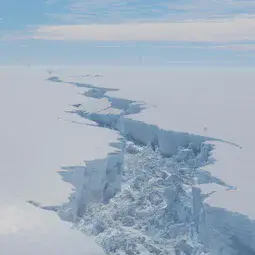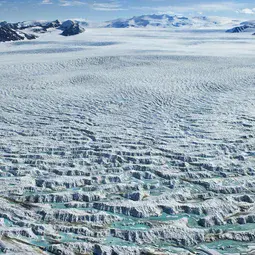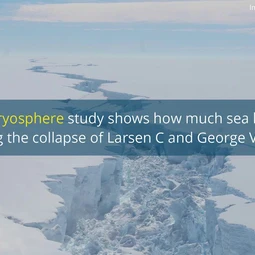New study puts a figure on sea-level rise following Antarctic ice shelves’ collapse
An international team of scientists has shown how much sea level would rise if Larsen C and George VI, two Antarctic ice shelves at risk of collapse, were to break up. While Larsen C has received much attention due to the break-away of a trillion-tonne iceberg from it last summer, its collapse would contribute only a few millimetres to sea-level rise. The break-up of the smaller George VI Ice Shelf would have a much larger impact. The research is published today in the European Geosciences Union journal The Cryosphere.
Recent, rapid warming in the Antarctic Peninsula is a threat to ice shelves in the region, with Larsen C and George VI considered to have the highest risk of collapse. Because these large ice platforms hold back inland glaciers, the ice carried by these glaciers can flow faster into the sea when the ice shelves collapse, which contributes to sea-level rise. The new study shows that a collapse of Larsen C would result in inland ice discharging about 4 mm to sea level, while the response of glaciers to George VI collapse could contribute over five times more to global sea levels, around 22 mm.
“These numbers, while not enormous in themselves, are only one part of a larger sea-level budget including loss from other glaciers around the world and from the Greenland, East and West Antarctic ice sheets. Taken together with these other sources, the impacts could be significant to island nations and coastal populations,” explains study-author Nicholas Barrand, a glaciologist at the University of Birmingham in the UK. He adds: “The Antarctic Peninsula may be seen as a bellwether for changes in the much larger East and West Antarctic ice sheets as climate warming extends south.”
Warming in the Antarctic Peninsula led, in 2002, to the dramatic collapse of Larsen B, an ice shelf just north of Larsen C. Unprecedented in its size, almost the entire ice shelf broke up in just over two weeks after being stable for the last 10,000 years.
“Larsen C is the most northerly remaining large ice shelf, therefore subject to the warmest temperatures, and the likeliest candidate for future collapse. George VI is further west and south, in a slightly cooler climate, but is still vulnerable to a warming atmosphere and ocean,” says lead-author Clemens Schannwell, who conducted the work while at the University of Birmingham and the British Antarctic Survey.
Last summer, an iceberg twice the size of Luxembourg broke away from Larsen C. But despite the recent attention on this ice shelf, the team found its future collapse would have a modest effect on global sea level. By using computer models to simulate the interactions between the Antarctic Peninsula ice sheet and the ice shelves, the team found that the glacier response to collapse of Larsen C would add up to 2.5 mm to sea level by 2100 and 4.2 mm by 2300.
“The vulnerability to change at George VI Ice Shelf and the possible sea level implications from these changes, are far greater,” says Schannwell. Sandwiched between the Antarctic Peninsula and Alexander Island, George VI Ice Shelf is, at 24,000 square kilometres, around half the size of Larsen C. But it would contribute far more to sea-level rise because it is fed by larger glaciers and is very effective at holding back the ice that drains into it from these glaciers. According to the simulations presented in the new The Cryosphere study, adjustment of the glaciers flowing into it following a collapse could contribute up to 8 mm to global sea levels by 2100 and 22 mm by 2300.
“Prior to our work, we didn’t know what would happen to the upstream ice in the Antarctic Peninsula if these shelves were to be lost. This could have important implications for the local environment and for global sea levels, information that is essential for climate-change mitigation planning and policy,” says Schannwell, who is now at the University of Tübingen in Germany.
“In light of the increasing temperatures projected for the coming century, the Antarctic Peninsula provides an ideal laboratory to research changes in the integrity of floating ice shelves. This region can tell us about ice shelf processes and allow us to observe the response of inland ice to ice-shelf changes. We should view these dramatic changes in the Antarctic Peninsula as a warning signal for the much larger ice sheet-ice shelf systems elsewhere in Antarctica with even greater potential for global sea-level rise.” concludes Barrand.
###
Please mention the name of the publication (The Cryosphere) if reporting on this story and, if reporting online, include a link to the paper (https://www.the-cryosphere.net/12/2307/2018/) or to the journal website (https://www.the-cryosphere.net).
More information
This research is presented in the paper ‘Dynamic response of Antarctic Peninsula Ice Sheet to potential collapse of Larsen C and George VI ice shelves’ published in the EGU open access journal The Cryosphere on 19 July 2018.
This work was supported by the University or Birmingham including the BlueBear HPC service, the UK Natural Environment Research Council (NERC British Antarctic Survey and Centre for Polar Observation and Modelling), and Earth and Environmental Systems Institute (Penn State University, USA).
Citation: Schannwell, C., Cornford, S., Pollard, D., and Barrand, N. E.: Dynamic response of Antarctic Peninsula Ice Sheet to potential collapse of Larsen C and George VI ice shelves, The Cryosphere, 12, 2307–2326, https://doi.org/10.5194/tc-12-2307-2018, 2018.
The study was conducted by Clemens Schannwell (University of Birmingham and British Antarctic Survey, UK), Stephen Cornford (University of Bristol, UK), David Pollard (Pennsylvania State University, US) and Nicholas E. Barrand (University of Birmingham, UK).
The European Geosciences Union (EGU) is Europe’s premier geosciences union, dedicated to the pursuit of excellence in the Earth, planetary, and space sciences for the benefit of humanity, worldwide. It is a non-profit interdisciplinary learned association of scientists founded in 2002 with headquarters in Munich, Germany. The EGU publishes a number of diverse scientific journals, which use an innovative open access format, and organises a number of topical meetings, and education and outreach activities. Its annual General Assembly is the largest and most prominent European geosciences event, attracting over 14,000 scientists from all over the world. The meeting’s sessions cover a wide range of topics, including volcanology, planetary exploration, the Earth’s internal structure and atmosphere, climate, energy, and resources. The EGU 2019 General Assembly is taking place in Vienna, Austria, from 7 to 12 April 2019. For information and press registration, please check https://media.egu.eu closer to the time of the meeting, or follow the EGU on Twitter and Facebook.
If you wish to receive our press releases via email, please use the Press Release Subscription Form at http://www.egu.eu/news/subscribe/. Subscribed journalists and other members of the media receive EGU press releases under embargo (if applicable) at least 24 hours in advance of public dissemination.
The Cryosphere (TC) is an international scientific journal dedicated to the publication and discussion of research articles, short communications, and review papers on all aspects of frozen water and ground on Earth and on other planetary bodies. The main subject areas are ice sheets and glaciers, planetary ice bodies, permafrost, river and lake ice, seasonal snow cover, sea ice, remote sensing, nu-merical modelling, in situ and laboratory studies of the above and including studies of the interaction of the cryosphere with the rest of the climate system.
Contact
Scientists
Clemens Schannwell
Postdoc, University of Tübingen, Germany
(formerly at the University of Birmingham and the British Antarctic Survey, UK)
Phone+49(0)7071 29 73141
Emailclemens.schannwell@uni-tuebingen.de
Nicholas Barrand
Lecturer in Geosciences, School of Geography, Earth and Environmental Sciences
University of Birmingham, UK
Phone+44 (0)121 414 3103
Emailn.e.barrand@bham.ac.uk
Press officers
Bárbara Ferreira
EGU Media and Communications Manager
Munich, Germany
Phone+49-89-2180-6703
Emailmedia@egu.eu
Twitter: @EuroGeosciences
Kate Chapple
Media Relations Manager
University of Birmingham
Phone+ 44 (0) 121 414 2772 or + 44 (0) 7789 921164
Emailk.h.chapple@bham.ac.uk
Twitter: @unibirmingham
Athena Dinar
Senior Science Communication Press & PR Manager
British Antarctic Survey
Phone+44 (0) 1223 221441
Emailamdi@bas.ac.uk
Twitter: @BAS_News
Links
- Scientific paper
- Journal – The Cryosphere
- Read this press release in simplified language, aimed at 7–13 year olds, on our Planet Press site




